
About UsThe Numismatic Bibliomania Society is a non-profit organization promoting numismatic literature. For more information please see our web site at coinbooks.org SubscriptionsThose wishing to become new E-Sylum subscribers (or wishing to Unsubscribe) can go to the following web page link MembershipThere is a membership application available on the web site Membership Application To join, print the application and return it with your check to the address printed on the application. Membership is only $15 to addresses in the U.S., $20 for First Class mail, and $25 elsewhere. For those without web access, write to: David M. Sundman, Secretary/TreasurerNumismatic Bibliomania
Society AsylumFor Asylum mailing address changes and other membership questions, contact David at this email address: dsundman@LittletonCoin.com SubmissionsTo submit items for publication in The E-Sylum, just Reply to this message, or write to the Editor at this address: whomren@coinlibrary.com
BUY THE BOOK BEFORE THE COINYou won't regret it! |
- WAYNE'S WORDS: THE E-SYLUM NOVEMBER 2, 2008
- DAVID FANNING NUMISMATIC LITERATURE AUCTION #1 PRL AVAILABLE
- NUMISMATIC LIBRARY OF ALEXANDER WILD AUCTIONED IN ZURICH
- JOHN BURNS SELLING LITERATURE IN CONNECTICUT, OHIO, MARYLAND AND MICHIGAN
- THREE FROM KRAUSE PUBLICATIONS TEAM LEAVING IN F+W DOWNSIZING
- NEW BOOK: COLLECTING ANCIENT GREEK COINS BY PAUL RYNEARSON
- BOOK REVIEW: PROFITABLE COIN COLLECTING BY DAVID L. GANZ
- BOOK REVIEW: ANCIENT GREEK NUMISMATICS: A GUIDE TO READING AND RESEARCH
- BRAILLE VERSION OF 1969 REDBOOK EXHIBITED IN ATLANTA
- 1876 HASELTINE ON CONFEDERATE NOTES: ORIGINAL VS. UNIDENTIFIED FACSIMILE
- RESEARCH ON GEORGE SOLEY UNCOVERS SECRET SERVICE BANNING OF U.S. MINT BOOK
- COIN WORLD ARTICLE FEATURES FANTASTIC 1804 DOLLAR BOOK VARIETIES
- DECEMBER 2008 COLONIAL NEWSLETTER PUBLISHED
- MORE ON THE ECONOMICS OF NUMISMATIC BOOK PUBLISHING
- QUERY: CONTACTING "THE COIN MAKERS" AUTHOR THOMAS W. BECKER
- TIPS ON USING BOOK SEARCH WEB SITES
- MORE ON THE 1838-O HALF DOLLAR
- DID LONGACRE HIDE A WITCH IN HIS FLYING EAGLE DESIGN?
- ALAN WEINBERG ON SMITHSONIAN EXHIBITS OF INDIAN PEACE MEDALS
- GEORGE WASHINGTON INAUGURAL AND FUNERAL ITEMS OFFERED
- HALF DOLLAR "TAKEN FROM MOSEBY THE GUERRILLA"
- ALASKA NATIVE GOLD TOKENS NOW STRUCK WITH COLLAR
- GOOGLE SETTLES LEGAL BATTLE, SETS UP BOOK RIGHTS REGISTRY
- CHINESE DEALER IN FAKE COINS SENTENCED TO JAIL
- ARTICLE DISCUSSES COIN'S "TREASURE IN THE CELLAR" CONNECTION
- ALPHONSE ANTON KOLB, SCULPTOR (1893 - 1983)
- WELSH TREASURE HUNTER UNEARTHS 6,000 COINS
- TALES OF CRANKY BOOKSELLERS
- NOTES AND CORRECTIONS
- NATIONAL COLLECTOR'S MINT COIN INCORPORATES LIGHT AND SOUND
- FEATURED WEB PAGE: MONETA'S E-PAPERS LINKS PAGE
WAYNE'S WORDS: THE E-SYLUM NOVEMBER 2, 2008
 Among our recent subscribers is Steve Rush.
Welcome aboard! We now have 1,209 subscribers.
Among our recent subscribers is Steve Rush.
Welcome aboard! We now have 1,209 subscribers.This week we open with some results from David F. Fanning Numismatic Literature's first mail-bid sale. Next, we have a report from Douglas Saville on last week's sale of the Alexander Wild numismatic library in Zurich. New books discussed this week include Rynearson's Ancient Greek Coins and David L. Ganz' Profitable Coin Collecting.
In other book news, we have photos of the recent Whitman Expo exhibit of the unique 1969 Braille Red Book and excerpts from last month's Coin World article on The Fantastic 1804 Dollar book.
Other topics include Indian Peace medals, Washington inaugural buttons, Alaska native gold tokens and cranky booksellers. To learn about Moseby the Guerrilla and which numismatic book was banned by the U.S. Secret Service, read on. Have a great week, everyone!
Wayne Homren
Numismatic Bibliomania Society
DAVID FANNING NUMISMATIC LITERATURE AUCTION #1 PRL AVAILABLE
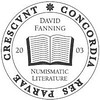 David F. Fanning Numismatic Literature's first
mail-bid sale closed October 28. We had over 100 bidders take part, from
eight different countries. Over 95% of the sale's total estimated value
was reached, which was very gratifying. Competition on some of the better
lots was very strong. Some highlights include:
David F. Fanning Numismatic Literature's first
mail-bid sale closed October 28. We had over 100 bidders take part, from
eight different countries. Over 95% of the sale's total estimated value
was reached, which was very gratifying. Competition on some of the better
lots was very strong. Some highlights include:- The plated copy of the 1886 Maris sale (lot 676) brought $5,600
- Lot 1, the Journal of the Senate containing the Act Establishing the Mint, sold for $4,200
- The Frossard volume containing six of his plated sales (lot 486) brought $4,100
- Elder's Gschwend sale with plates (lot 474) saw very spirited bidding and closed at $3,600
- The copy of Crosby in a Nova Constellatio binding (lot 182) sold for $2,100
- The U.S. Coin Co. sale of the Jackson collection (lot 717) brought $1,725.
Some bids received were exceptionally strong, indicating a solid market for this type of material. A few bids were reduced by more than $1,000. The prices realized list for the sale is available in PDF form from our Web site at www.fanningbooks.com .
Consignments are being sought for future auction sales: for more information, please contact David Fanning at dfanning@columbus.rr.com .
NUMISMATIC LIBRARY OF ALEXANDER WILD AUCTIONED IN ZURICH
Last week the Swiss firm of Hess-Divo auctioned the numismatic library of Alexander Wild (Die numismatische Bibliothek Alexander Wild). One E-Sylum reader attending the sale was Douglas Saville, who writes:There were some bargains as usual in such sales. I am pleased with what I bought, and my customers who gave me bids are also pleased...on the whole the prices were very high, and shows interest in books continues to be very strong. Apparently very few U.S. bidders participated unless they bid directly with the auction house. Was the economy a factor for them? It's very difficult to analyse, as with all sales of this kind.
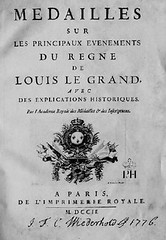
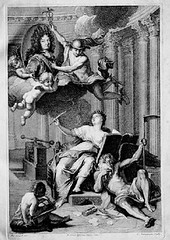
The illustrations here are of lot 2009:
To access the catalog, see the Hess-Divo web site: www.hessdivo.com
JOHN BURNS SELLING LITERATURE IN CONNECTICUT, OHIO, MARYLAND AND MICHIGAN
Numismatic literature dealer John Burns writes:November 7-9
Coinfest
Hilton Executive Meeting Center
One First Stamford Place
Stamford, CT
November 14-16
Ohio Coin Expo
Quality Inn
Richfield, Oh
November 20-22 (No Sunday)
Whitman Coin Show
Baltimore Convention center
November 27-30
Michigan State Show
Hyatt Regency
Dearborn MI
THREE FROM KRAUSE PUBLICATIONS TEAM LEAVING IN F+W DOWNSIZING
Colin is familiar to many as the longest serving member of the department joining the staff for the second edition of the Standard Catalog of World Coins series, and expanding that project back to 1600. He also championed development of the Standard Catalog of World Paper Money, as well as Unusual World Coins.
Randy Thern was for about half his time here part of the numismatic advertising division. Actually, it was by me placing ads for Stack's that my relationship with the company grew. In the late-1990s when KP bought the Minkus Stamp product line, I moved over to the stamp division and Randy moved into a spot in the numismatic book area, where he has remained. Responsibilities included working with our stable of outside authors such as David Ganz, Wayne Sayles, Ken Potter, Eric P. Newman and Scott Lindquist.
Sally Olson has been with the company since high school. She has been in the book production department, being our last connection to the days when the Standard Catalog was a paste-up production book and all 17,500 velox images has to be moved from the old to new pages for each new edition. She made the transition to electronic pagination, and has been ably producing our current line of books and DVDs.
To read George's original blog article, see: Colin Bruce, Randy Thern and Sally Olson, a Sad Parting (http://www.numismaster.com/ta/inside_numis.jsp?
page=BlogEntry&BlogEntryId=1823)
NEW BOOK: COLLECTING ANCIENT GREEK COINS BY PAUL RYNEARSON
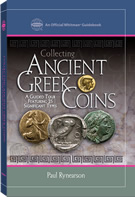 With Collecting Ancient Greek Coins, Dr.
Rynearson provides an engaging introduction to many diverse aspects of
these fascinating relics. He offers an expert.s valuable guidance to what
he calls the .highly personal. act of building your own collection.
With Collecting Ancient Greek Coins, Dr.
Rynearson provides an engaging introduction to many diverse aspects of
these fascinating relics. He offers an expert.s valuable guidance to what
he calls the .highly personal. act of building your own collection.
In more than two dozen essays, Rynearson teaches important lessons in how to get started, how to evaluate quality and value, how to grade ancient coins, and how to catalog and photograph your collection. He discusses forgeries in the marketplace, the risks of cleaning coins, and other concerns for the modern collector.
He shares a longtime collector.s wealth of knowledge on coin types, denominations, classifications, and valuations; and a historian.s enthusiasm for coin hoards, famous collections and collectors of the past, symbolism and references on ancient coins, and favorite books for further study.
Having laid a superb foundation, Rynearson next applies his lessons to what might be termed an .action guide. to assembling a personal collection of 25 distinct types of ancient Greek coins. He explores Athenian owls, coins of the Bible, Greek Imperial issues, and other evergreens.those classic coins that collectors have always appreciated, and always will.
To read the complete article, see: Collecting Ancient Greek Coins A Guided Tour Featuring 25 Significant Types (http://www.whitmanbooks.com/Default.aspx?
Page=55&HTMLName=ReviewUpcoming_1108)
BOOK REVIEW: PROFITABLE COIN COLLECTING BY DAVID L. GANZ
 Profitable Coin Collecting by David L.
Ganz is a different kind of investment book. Most books of the genre are
broadly focused, and the first few chapters of Ganz' new work are similar,
with charts, graphs and text showing the price performance of rare coins
vs other benchmarks including stocks and bonds, silver, gold, platinum,
and even Iowa farmland ($77.91/acre in 1935, $3,500/acre in
2007).
Profitable Coin Collecting by David L.
Ganz is a different kind of investment book. Most books of the genre are
broadly focused, and the first few chapters of Ganz' new work are similar,
with charts, graphs and text showing the price performance of rare coins
vs other benchmarks including stocks and bonds, silver, gold, platinum,
and even Iowa farmland ($77.91/acre in 1935, $3,500/acre in
2007).Longtime collectors would be pleased with the analysis. Where the Consumer Price Index increased an average of 4.4% annually, coin show a rate of change about 12%.
Your mileage, of course, may vary. Much depends on what coins you buy, and when you buy and sell them. Over 75 years however, Ganz' marketbasket of coins showed a negative appreciation in only ten of those years. As an example of the high end potential of coin investing, Ganz highlights the collection of Harold Bareford.
The former general counsel of Warner Brothers Pictures, Bareford built his collection of 242 choice coins from 1941 to 1954, spending a total of $13,832.15. When the collection was sold by Stack's in 1978, the coins realized an astounding $1,207,205. Few collectors can match Bareford's "Midas touch". He was very selective, choosing only the finest examples. Still, his success is something all coin collectors and investors can aspire to.
It's hard to argue with Ganz' general recommendations. One series I certainly agree on are low mintage modern commemoratives. A nicely illustrated section (p128-138) provides a good overview including handy charts listing modern commemorative gold coins with mintage under 30,000 and modern silver dollar and half dollar commemoratives with mintages under 55,000.
The remaining chapters (4 through 12) examine the stories and detailed price history of nine specific representative coins:
- 1794 Silver Dollar
- 1909-S "V.D.B." Cent
- 1838-O Half Dollar
- 1913 Liberty Nickel
- 1946-P War Nickel
- 1804 Silver Dollar
- 1894-S Dime
- 1933 Gold $20
- 1993 Thomas Jefferson Silver Dollar
Many of these are marquee rarities impractical for the average collector or investor to obtain. But some are quite accessible, and the mix provides an interesting overview of U.S. coinage and collecting. Here's where Ganz did extensive homework - to collect price history he gathered records of coin sales over several decades with the help of several researchers, including a few inquiries here in The E-Sylum. Ganz listed my name in the acknowledgements, but our readers deserve the honor.
The book's pedigree and pricing information goes well beyond what typical coin investment books provide. But despite all efforts, additional information can often be found, as illustrated by responses elsewhere in this issue regarding sales of the 1838-O half dollar. But that's all the more reason to anticipate a second edition.
For more information, or to order a copy, see: Profitable Coin Collecting By David L. Ganz (http://www.krausebooks.com/product/1011/coins_papermoney)
BOOK REVIEW: ANCIENT GREEK NUMISMATICS: A GUIDE TO READING AND RESEARCH
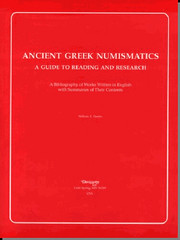 ANCIENT GREEK NUMISMATICS: A GUIDE TO
READING AND RESEARCH - A Bibliography of Works Written in English with
Summaries of Their Contents By William E. Daehn. Cold Spring:
Davissons Ltd., 2001. 401 pages.
ANCIENT GREEK NUMISMATICS: A GUIDE TO
READING AND RESEARCH - A Bibliography of Works Written in English with
Summaries of Their Contents By William E. Daehn. Cold Spring:
Davissons Ltd., 2001. 401 pages.From the author's web page:
The page quotes Basil Demetriadi:
"...as near complete as humanly possible. One cannot help admiring and respecting the author for his meticulousness and dedication."
"For the collector who is ready to respond to the mental challenge of advancing from Roman coin collecting to the mind blowing world of Greek coinages, this treasure house of information will become the guiding light in a new and infinitely more fascinating realm."
Athens-based Basil Demetriadi is the ultimate bibliophile of Greek numismatics, so this is high praise indeed. In his blog Ed Snible writes:
Although easy to use this book can be frustrating to operate at home because it points out tantalizing sources that are expensive or unobtainable.
ancient-greek-numismatics-guide-to.html)
For more information on the author's web page, see: My Book (http://home.comcast.net/~wdaehn/page3.html)
For the Harlan Berk web site, see: www.harlanjberk.com
BRAILLE VERSION OF 1969 REDBOOK EXHIBITED IN ATLANTA
John and Nancy Wilson, Ocala, FL write:Quoting information from the exhibit, "Davyd Pepito, a blind 17-year old coin collector in California was in need of A Guide Book of United States Coins (the "Red Book") in Braille. The nonprofit group Uncap International took on the challenge and produced a nine-volume Braille edition of the 1969 Red Book."
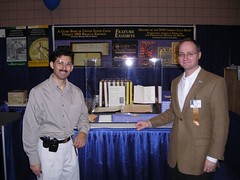

To see more images of Rich Mantia's Redbook collection (including the Braille edition), see: Rich Mantia's Redbook photos (flickr.com/photos/coinbooks/sets/72157604113900589/show/)
1876 HASELTINE ON CONFEDERATE NOTES: ORIGINAL VS. UNIDENTIFIED FACSIMILE
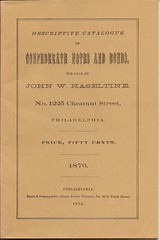 Last week Fred Reed initiated a census of four
rare works on Confederate currency, including John W. Haseltine's
Descriptive Catalogue of Confederate Notes and Bonds, 1876. I
published an image of the copy in my library, which is reprinted
here.
Last week Fred Reed initiated a census of four
rare works on Confederate currency, including John W. Haseltine's
Descriptive Catalogue of Confederate Notes and Bonds, 1876. I
published an image of the copy in my library, which is reprinted
here.George Kolbe writes:
A Large Paper copy is featured in my January 10, 2009 sale. I believe the printing is identical to the regular 1876 edition.
George added the following notes on how to identify the Haseltine reprint:
2) The paper and cover stock is quite different from that manufactured in the nineteenth century;
3) the cover border already mentioned (in the original the inner line is quite thin and was probably too difficult to replicate with the technology of the time and in the reprint both lines are of similar width).
RESEARCH ON GEORGE SOLEY UNCOVERS SECRET SERVICE BANNING OF U.S. MINT BOOK
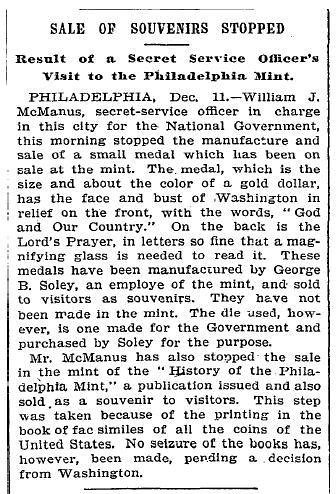 I was adding to my entry on George B. Soley in
my artists databank this week and discovered the U.S. Secret Service once
stopped the sale of "History of the Philadelphia Mint" to quote the news
article I found in the New York Times for December 12, 1894.
I was adding to my entry on George B. Soley in
my artists databank this week and discovered the U.S. Secret Service once
stopped the sale of "History of the Philadelphia Mint" to quote the news
article I found in the New York Times for December 12, 1894. The book was obviously George Evans' Illustrated History of the United States Mint (the NYT got the title wrong!).
The news article stated that the Secret Service officer in charge of the Philadelphia office, William J. MacMannus, stopped the U.S. Mint from selling copies of the book. Reason? It contained "fac similies [read illustrations] of all the coins of the United States."
He didn't confiscate any books. "No seizure of the books, has, however, been made, pending a decision from Washington," continued the news article, which was the second paragraph under the headline "Sale of Souvenirs Stopped."
The main thrust of the news article -- and this was my research interest -- was the item in the first paragraph. While still on the staff of the Philadelphia Mint Engraving Department, George B. Soley had purchased the first steam press -- as surplus! -- from the Mint in 1875. (This press was later donated to the Franklin Institute in 1927 by Soley's widow, and even later, in 2000, to the American Numismatic Association, and is now ensconced in a plastic box outside ANA Headquarters in Colorado Springs.)
Soley refurbished the press so it was able to run manually and he carted it to Philadelphia parades and fairs. For the American Centennial Exposition in 1876 he struck medals in two sizes: silver-dollar size medals from eight dies with frequent muleing (these were HK 48 to HK 72c) and gold-dollar size mostly with the Lord's Prayer and the Liberty Bell.
For the latter he had purchased obsolete tooling from the Mint, like 12.7mm collars and blanking dies formerly used for the U.S. gold dollar of 1849-54. He did all his striking on his own time in his own residence, from dies we assumed he engraved himself. Philadelphia Mint officials were aware of what he was doing and perhaps encouraged him. The Mint itself was selling Soley's homemade medals.
But it was these little medalets with an obverse portrait of Washington and the Lord's Prayer on the reverse (Baker 651) that Secret Service agent MacMannus halted the sale of, along with Evans' book, at the Mint in December 1894. (Rulau tells us Soley sold these medalets for 25 cents at the Chicago Columbian Exposition in 1893.)
Contrast that with the present day's gift shop in the Philadelphia Mint. I am certain agent MacMannus wouldn't have stepped foot inside the Mint's door. Let's hope MacMannus was censured from Washington for overstepping his authority two weeks before Christmas in 1894.
For more information on the Mint's steam press, see: Steam-Powered Coin Press (http://www.fi.edu/learn/sci-tech/coin-press/
coin-press.php?cts=instrumentation)
COIN WORLD ARTICLE FEATURES FANTASTIC 1804 DOLLAR BOOK VARIETIES
 The October 20 and October 27, 2008 issues of
Coin World feature a great article by Paul Gilkes on the
publication of The Fantastic 1804 Dollar by Eric Newman and Ken
Bressett. Paul contacted me while doing his research and I was able to
provide him with information about the book and the rare bound page proof
variety.
The October 20 and October 27, 2008 issues of
Coin World feature a great article by Paul Gilkes on the
publication of The Fantastic 1804 Dollar by Eric Newman and Ken
Bressett. Paul contacted me while doing his research and I was able to
provide him with information about the book and the rare bound page proof
variety.The Newman-Bressett book in its original form contained a chapter concluding that the diplomatic gift origin of the set was a "delusion."
When David Spink walked into the 1962 American Numismatic Association convention in Detroit, he was carrying with him proof to the contrary - the now-famous "King of Siam" presentation set, complete with an 1804 dollar.

Copyright 2008 by Amos Press Inc, Oct. 20, 2008, issue of Coin World.
Reprinted by permission.
Coin World created a nice graphic highlighting a key diagnostic, the differences in the Table of Contents of both editions. Great job all around - it's gratifying to see an article about an important piece of numismatic literature featured in a mainstream publication. By the way, the October 20th issue also included a nice column by Col. Bill Murray on "Book Fanatics", The E-Sylum, and the Numismatic Bibliomania Society. Thanks, Coin World!
THE BOOK BAZARRE
DECEMBER 2008 COLONIAL NEWSLETTER PUBLISHED
 The December 2008 issue of The Colonial
Newsletter: A Research Journal in Early American Numismatics (CNL) has
been published. In this issue, we are pleased to announce a significant
CNL subscription price rollback starting in 2009. The new subscription
prices are: $25 per year for ANS members and $40 per year for non-ANS
members. Take advantage of this price reduction and contact the ANS to
subscribe.
The December 2008 issue of The Colonial
Newsletter: A Research Journal in Early American Numismatics (CNL) has
been published. In this issue, we are pleased to announce a significant
CNL subscription price rollback starting in 2009. The new subscription
prices are: $25 per year for ANS members and $40 per year for non-ANS
members. Take advantage of this price reduction and contact the ANS to
subscribe.This issue starts with a ground breaking paper on colonial currency by associate editor Lou Jordan. As Lou explains, many of us have held a coin from our colonial era and wondered where it traveled and who handled it - could one of our founding fathers have actually held this coin? While it is not likely we will ever discover this kind of information about this coin, colonial paper notes can often provide such insights through handwritten annotations. Deciphering the annotations on colonial notes can be difficult, however, which has resulted in very little study, until now, in this area of numismatics. Lou has tackled this challenge and presents some of his findings on several colonial notes from the Robert H. Gore, Jr. Collection. Several illustrations are included to illuminate his discussion.
In order to correctly interpret a particular coinage event, it is very helpful to understand the people that were involved with that coinage. Our next paper, authored by Brian Danforth, looks at the life and times of William Wood. Many of us are familiar with the name of the man responsible for the Hibernia and Rosa Americana coinages but outside of this information, who was William Wood? What were his ambitions, his successes, and his failures? Who were his parents, his wife, and his children? And, importantly, why was he interested in coinage? Brian answers these questions and more in a superbly researched and written paper.
Our final contribution to this issue is a technical note discussing the discovery of yet another Atlee halfpenny die. George Seifrit reports on a newly found 1778-dated reverse die that is married to the previously known Vlack 13 obverse die. It is the third die with this date and has appropriately been labeled Vlack 78C. A die state study of obverse Vlack 13 is included in an effort to determine when this new die was paired with it.
CNL is published three times a year by The American Numismatic Society, 75 Varick St., 11th Floor, New York, NY 10013. For inquires concerning CNL, please contact Megan Fenselau at the preceding postal address or e-mail fenselau@amnumsoc.org or telephone (212) 571-4470 ext. 1311.
MORE ON THE ECONOMICS OF NUMISMATIC BOOK PUBLISHING
Joe Boling writes:It's nice to keep prices low so that as many collectors as possible can afford them, but if you do that you have to be willing to be the only source for the book - with the concomitant costs of advertising being paid for out of your low markup. Few dealers will stock the book, even if you deliver it to them, if they cannot get their customary markup for it.
Next to chime in on the topic is John T. Dean, author of National Commemorative Medals of the United States Mint and co-editor of So-Called Dollars - An Illustrated Standard Catalog.
Secondly, having gathered much of my information from previous issues of The Numismatist, I felt it necessary and appropriate to acquire permission from the ANA to utilize their information, compiled into my book. I met with Barbara Gregory, Editor of The Numismatist, and gave her a very preliminary copy of my book at the time. I asked her openly and candidly how would be the best method to get this book published and into the hands of collectors. She told me that, in her opinion, self-publishing was the best course to take. My book was obviously not of enough importance to interest publishers.
As David Lange observed of Dick Johnson's reviews, self-published books often lack proper editing and graphic design. To this I also agree with David Lange. Involving an editor and/or graphic designer requires considerable extra expense, resulting in a higher priced book, which publishers didn't want to accept originally because of lack of opportunity to make money on a "limited" numismatic area.
I also edited text and graphics myself, having knowledgeable friends review my work for typographical errors as well as technical or informational errors. This worked well, and like David Lange, I also could not offer hefty discounts to retailers, pricing my book at a level to be accepted by collectors, knowing in advance that the collecting public for these items and the book, are at this time limited. My motive was not profit, but making a work that collectors would find useful and enduring, and satisfying my own desire to create a work of which I am proud. My public response to my book has been nothing but positive, to which I am pleased.
David Lange is correct in stating that getting people aware of his book was difficult to say the least. I agree wholeheartedly. I have given away more books than I have sold, because my main goal was to get the book into the hands of the dealers, collectors and the collecting community, in order to make people aware of the book. I have my book available at my web site, I have sold others by "pounding the pavement", and sold others through various web locations.
Even though my book has an ISBN and is bar-coded for commercial sales, the likelihood of it being sold through such locations as Amazon or Barnes & Noble or etc., is quite unlikely, because their required up front discounts would require me sell the book at below my original costs. As Dick Johnson would say "Don't do that".
In summary, my personal opinion is that self-publishing has a definite place in numismatic reference, and especially in the limited areas/specialties of numismatics. I would highly recommend anyone wishing to publish information valuable to numismatists, limited as it may be, to either write an article for TAMS or other worthy organizations, a pamphlet or book, and have it self published. The efforts and personal achievements gained are worth the time and pleasure derived. Comparing a work of this limited nature to other more defined and elaborate areas of numismatics is not a true comparison in my opinion.
QUERY: CONTACTING "THE COIN MAKERS" AUTHOR THOMAS W. BECKER
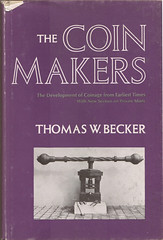 Len Augsburger writes:
Len Augsburger writes:
We believe this is not the same Tom Becker of Bowers & Merena fame, who is still in the business in New Hampshire. Thomas W. Becker unearthed a portion of the Frank Stewart first Mint collection in Philadelphia in the 1960s, the focus of our research.
TIPS ON USING BOOK SEARCH WEB SITES
This last site is now owned by Ebay but runs separately. The difference between Half.com and the other sites is that on Half.com the listed book must have an ISBN (International Standard Book Number) number. These numbers (originally a 10 digit number, now there are also 13 digit numbers) were first used in the mid 1970's, so if the book you are looking for was published before then, chances are you won't find it on Half.com.
There are exceptions, however. If a book has been reprinted since the mid-1970's, it usually gets an ISBN number. Some sellers (myself included) will sometimes list an old book under the ISBN of the reprint, with a note that it is actually an original. The other exception is that some big sellers are able to create acceptable ISBN numbers for old books. I don't know how they do it, but when I check the price of a book I am about to list, sometimes the "created" number shows up, and I can list the old book on Half.com (as well as ABE, where I normally list all pre-1970 books).
Some things to keep in mind. The first few digits of the ISBN number indicate the printer. If a book was printed by more than one printer, there can be more than one ISBN number for it. This is particularly true when a new release is printed in both the USA and Europe. Different editions and reprints of a book may or may not have different ISBN numbers. Also the paperback and hard cover versions normally have different ISBN numbers.
And a tip. When searching for a book on one of the book sites, enter the minimum possible information in the search boxes to get the best results. That means, don't list the author's full name, just the last name. And you only need to type in the important words of a title, not the full title. The search engine automatically deletes works like a, an, the, to, of, and, and so on.
Each seller lists his books differently. Some list the whole name, including middle name, some list only first and last name, and some use initials. If you enter the full name, your search will only find those books which were listed with the full name --- you will miss all those with an initial for the middle name and those in which the middle name was omitted.
So if you want to find The Decline and Fall of the Roman Empire by Edward Gibbon, all you need to enter is "Gibbon" and "Decline Roman Empire". You could leave out "Decline" but it may pull up other books on the Roman Empire by some other guy named Gibbon. Your goal should be to pull up the maximum number of examples of any book you are looking for. Chances are the lazy seller who entered the minimum amount of information in his listing probably has the lowest price for the book.
By the way, most of the book sites have a "Want List" feature, which you can set up to notify you automatically when a copy of a particular book comes up for sale. And keep in mind that these book sites are fixed price sites -- when you see a book for sale, you can buy it immediately at the price shown.
One book I had been looking for for 20 years turned up in an automatic email one day. The book is worth $200, but it turned up at 75 cents. I thought it was a mistake for $75 and ordered it immediately. No mistake -- I got the book for 75 cents plus postage. The seller had just bought out another dealer -- tens of thousands or hundreds of thousands of books -- and rather than look up each one, he just listed everything at 75 cents to bring in some quick cash! Good Hunting!
MORE ON THE 1838-O HALF DOLLAR
Responding to a note in Karl Moulton's Winter 2008 numismatic literature fixed price list, last week I wrote: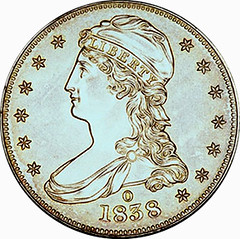 John N. Lupia III writes:
John N. Lupia III writes:
I do not have David Ganz's book so I do not know what he includes. My research is focused on 19th century numismatics and I have the following to report to offer.
[01] Mason's Coin Collector's Herald, Vol. 1, No. 4, March (1880) : 33, cites an uncirculated one in the cabinet of the US Mint. Currently, the Smithsonian specimen. Sent to Robert M. Patterson, Director of the US Mint. However, no mention of it is made in his annual report to Congress. (see scan) Mason's Coin Collector's Herald, Vol. 2, No. 2, September (1880) : 14, cites six known specimens including the US Mint cabinet already mentioned as well as that owned by James B. Clemens which was cataloged by Ed Cogan and sold by Messrs. Bangs & Co., on October 22, 1878. He also mentions one in a collection in Nevada, another in Lynn, Massachusetts, and another owned by C. H. Brenner, Jefferson, New York. A rubbing of one was sent in to Mason from Texas which he was negotiating to buy.
[02] James B. Clemens, cataloged by Ed Cogan and sold by Messrs. Bangs & Co., on Octobe7r 22, 1878.
[03] December 16-17, 1880, John W. Haseltine, Cataloger, Catalogue of Charles A. Besson Collection, of Philadelphia . . . . Bangs & Co. Charles Steigerwalt listed the price realized "1838-O half dollar, uncirculated, $23.50" (Besson sale) in his article, .Coin Sales,. The Coin Journal, Vol. 2, No. 2, March (1881) : 2
[04] Nevada, as per E. L. Mason, Jr. Nothing is known of this person.
[05] Lynn, Massachusetts, as per E. L. Mason, Jr. There was an S. L., Lynn, cited in Mason.s Monthly Illustrated Coin Collectors. Magazine, Vol. I, No. 1, June (1884) : 13; a long shot since I do not know where S. L. Lee lived but his coin collection was sold by John Walter Scott on June 12, 1899. Regardless, we have only straws to grasp to decipher who this anonymous person could be.
[06] C. H. Brenner, Jefferson, New York, as per E. L. Mason, Jr. However, we also find a C. R. B., Jefferson, Soho County, New York, cited in Mason.s Numismatic Herald, Vol. II, No. 1, June (1880) :2d, leaving us to wonder if this is C. R. Brenner or C. H. Brenner, or else a unlikely but possible coincidence of similar initials of coin collectors from the same place at the same time.
[07] Texas, as per E. L. Mason, Jr. Nothing is known of this person.
Some of he remaining specimens cited maybe redundant of those cited above since the provenance of purchasers are not listed in my files. E-Sylum readers may contribute to clarifying the census if they have priced catalogs with buyer.s names.
[08] Ferguson Haines specimen cataloged by the Chapman brothers sold at Davis & Harvey, Philadelphia, on October 17, 1888. Later called the Empire Specimen. See below.
[09] The Robert Coulton Davis specimen cataloged by David Proskey and Harlan Page Smith of the New York Coin & Stamp Company (3rd Sale) sold by Bangs & Co., on January 20-24, 1890, with a lot description commentary from Dr. Riddell, superintendent N.O. Mint, 1838, which accompanied a similar half dollar, in which it was stated that only four half dollars of this date and mintage were issued . . .. Heritage Auction Galleries who follow Breen, Walter Breen.s Complete Encyclopedia of U. S. and Colonial Coins (New York : Doubleday, 1988) : 391 (no. 4) the provenance of the Norweb Specimen. J.N.T. Levick; W. Elliot Woodward; R. Coulton Davis; Lorin G. Parmelee (New York Coin and Stamp Co., 6/1890), lot 655; James B. Wilson (Thomas Elder, 10/1908), lot 346; Albert Fairchild Holden; Emery May Holden (Mrs. R. Henry Norweb); Norweb family (Bowers and Merena, 11/1988), lot 3119; unknown; Andrew Lustig. http://coins.ha.com/common/view_item.php?Sale_No=376&Lot_No=6244&type=prte-pr060305b&ic=
According to Breen (op. cit) and Heritage, sometime between 1880 and 1890 the above specimen passed from Joseph Napoleon Tricot Levick (1828-1908), to William Elliot Woodward (1825-1892), to Robert Coulton Davis (1813-1888), and was purchased by Lorin Gilbert Parmelee (1827-1905).
[10] Professor Alexander D. Bache was given one as a gift from Rufus Tyler the coiner. The Professor William M. Friesner specimen was cataloged and sold by Edouard Frossard on June 7-8, 1894. Frossard mentions this in an article, .The 1838 Half Dollar New Orleans Mint,. The Numismatist, Vol. 7, No. 7, July (1894) : 138 (see scan) The specimen was purchased by Augustus Goodyear Heaton (1844-1931). The note from Tyler was given to Heaton by Benjamin H. Collins (1845-1928), an employee of the Treasury Department, who, was also a Philadelphia and Washington, D.C. coin dealer specializing in early American coppers.
[11] The Chapman brothers cataloged a specimen belonging to one of the consigners, either Elisha Turner, Joseph Hooper, George J. Bauer, Louis Winkler, or J. C. Trenaman that sold at Davis & Harvey, Philadelphia, on February 5-6, 1903.
[12] The William H. Bridgham proof specimen cataloged by David Proskey and Harlan Page Smith of the New York Coin & Stamp Company (23rd Sale) sold by May 26-27th, 1908
Nota Bene : Colonel Edward Howland Robinson Green (1868-1936), son of Hetty Green .The Witch of Wall Street., apparently owned seven specimens according to Walter H. Breen (vide supra) Note : Breen incorrectly cited The Numismatist as Vol. 4 1894, 198. It should be Vol. 7, page 138. See also below in asterisks.
Additional specimens also cited by Heritage Auction Galleries on the above link.
*Cox Specimen. Col. E.H.R. Green; Burdette G. Johnson; Wayte Raymond; J.G. Macallister; Charles M. Williams (a likely owner); Numismatic Gallery; Adolphe Menjou Collection; R.E. Cox, Jr. (Stack's, 4/1962), lot 1873; Empire Coin Co. (Q. David Bowers and James E Ruddy); Hazen B. Hinman (Paramount, Century Collection, 4/1965), lot 1151; unknown; Bowers and Ruddy Galleries (Rare Coin Review #17); Ellis H. Robison (Stack's, 2/1982), lot 1605; Marvin Browder.
*Neil Specimen. Waldo C. Newcomer; Henry Chapman; Col. E.H.R. Green; Maurice Ryan; B. Max Mehl (May 1945), lot 936; Will W. Neil (B. Max Mehl, 6/1947), lot 580; James Aloysius Stack (Stack's, 3/1975), lot 415; Julian Leidman; New York City Collection; Steve Ivy (ANA sale, 8/1982), Lot 2320; Anthony Terranova; Kevin Lipton; George W. Vogt (Colonial Coins); RARCOA (Auction '84), lot 1666; David Queller (Stack's, 10/2002), lot 446. The enlarged reverse in the Queller Catalog is incorrect, and is actually the 1836 Reeded Edge Half Dollar.
*Atwater Specimen. Col. E.H.R. Green; William Cutler Atwater (B. Max Mehl, 6/1946), lot 555; unknown; Reed Hawn (Stack's, 8/1973), lot 122; Superior (Auction '79), lot 1569; James Bennett Pryor (Bowers and Merena, 1/1996); Doug Noblet; Bowers and Merena (10/2000).
*Baldenhofer Specimen. The coin presently offered. Col. E.H.R. Green; W.G. Baldenhofer (Stack's, 11/1955), lot 708; Robert Pelletreau (Stack's, 3/1959), lot 782; Jerome L. Cohen; Lester Merkin; Q. David Bowers; Charles Jay (Stack's, 10/1967), lot 181; Dr. E. Yale Clarke (Stack's, 10/1975), lot 253; Julian Leidman; NASCA (Bryan Collection, 11/1977), lot 708; Julian Leidman; Paramount (Auction '82), lot 1689; unknown; the present example.
*Boyd Specimen. Col. E.H.R. Green; Wayte Raymond; F.C.C. Boyd; Numismatic Gallery ("World's Greatest Collection," 4/1945), lot 410; Stack's (1971 ANA sale), lot 805; Dr. George J. Oviedo (Stack's, 9/1983), lot 830.
*Anderson-Dupont Specimen. Col. E.H.R. Green; Anderson-Dupont sale (Stack's, 11/1954), lot 2104; Mr. Gottschalk; Federal Coin Exchange (1957 ANA sale), lot 1535A; "TAD" Collection (Stack's); Julian Leidman; Steve Ivy; Manfra, Tordella, and Brookes; Kagin's (1983 ANA), lot 2494; Mid-American (5/1985), lot 392; Kagin's (1986 ANA sale), lot 4657A; H.W Blevins (Superior, 6/1988), lot 3567; Bowers and Merena (3/1989), lot 2000; Vintage Auctions (8/1989), lot 202.
*Empire Specimen. New Orleans private collection; Ferguson Haines; (S.H. & H. Chapman, 10/1888), lot 483; Col. E.H.R. Green; Charles A. Cass (Stack's, Empire Collection, 11/1957), lot 1344; Stack's "Empire Collection" sale, November 1957, Lot 1344; New Netherlands Coin Company; Jerome L. Cohen; Kreisberg-Schulman (4/1967), lot 1065; Kreisberg Mail Bid Sale (6/1970), lot 1044.
Guggenheimer Specimen. Fred S. Guggenheimer (Stack's, 10/1953), lot 830. (#6226)
David L. Ganz writes:
Regarding the Mint cabinet specimen, John adds:
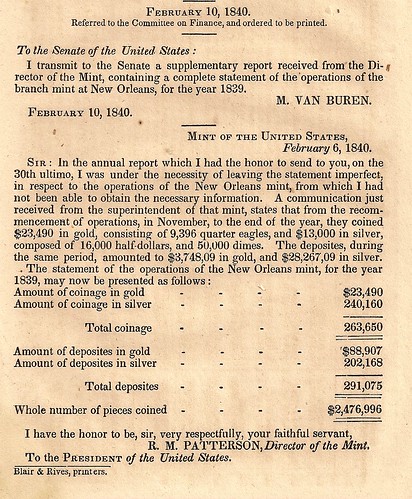
I sent this in so people who never saw this report can see it corroborated that there is no mention of the half dollar specifically. I do not have the 1838 report to see if any mention was made in it.
DID LONGACRE HIDE A WITCH IN HIS FLYING EAGLE DESIGN?
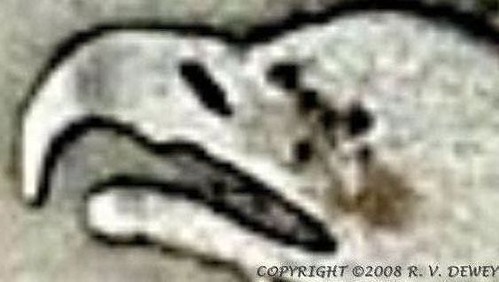
R.V. writes:
There is inexplicably no engraved detail visible on the entire head area of this .Proof. coin except for our cauldron girl, the .Witch!. The quintessential cartoon Witch: (large floppy hat, big nose and an overly exaggerated pointed chin), occupies the eye/head area and gazes forever to the East, thanks to Mr. J. B. Longacre.s macabre sense of humor. Stack.s considered this coin .rare. as struck surfaces, at the January 2007 Americana Sale. This coin is a slabbed J-171A Proof with noted Environmental Damage. For the record, I have never had this coin in a raw, unslabbed, state.
Within this very decade experts might have mistakenly proclaimed this coin a crude copy in the wrong alloy, or a spotted counterfeit of dubious origin. We have come a long way in just a few short years, expanding our knowledge of .real. patterns, but there is still a long, uncharted road to travel!
The Judd 171A is a perfect example of a previously unknown pattern coin that appears from seemingly nowhere. The existence of this German silver coin was only speculation and unrecorded for over 150 years. Even though we knew the Mint never used German silver for 1855 Flyers, this coin is indeed the real McCoy and certified as such! Apparently what we thought we knew for 150 years was proven totally inaccurate by the certification of several Judd 171A.s
In 1855, Mr. James Barton Longacre assembled for presentation and the Mint .cabinet,. extremely rare sets of eight pattern coins per set - one coin supposedly of each alloy. Who knew that German silver was one of J.B.L..s original eight alloys in 1855? No one! Each coin was hand engraved with an identifying Roman numeral.
The last recording of a Roman numeral engraved 1855 Flying Eagle Pattern Cent was, according to my research, over 100 years ago! Sadly, for numismatic historians, all contemporary pattern books have inexplicably omitted any mention of J.B.L..s rare Roman numeral Flying Eagle pattern sets. Are they all gone or just forgotten?
We know for a fact from Dr. Judd.s 5th Edition that these Extremely Rare Roman numeral eight piece sets did indeed exist! Who, among us, has the right to delete known numismatic history, verified in print, by the late Dr. J. Hewitt Judd M.D.? We must all answer in unison, .No One.!
Having two of Mr. Longacre.s Roman numeral 1855 Flying Eagle Patterns: numbers I and IIII; this glaring omission from all the pattern books, I find a little more than recondite! Witch Eye(TM) is Roman numeral .IIII. from Mr. J. B. Longacre.s long forgotten and extremely rare, complete eight piece, Mint sets.
R.V. adds this note, from The Comprehensive Catalogue & Encyclopedia of U. S. Coins, 1976, by Don Taxay (p198):
To read R.V.'s earlier E-Sylum query, see: 1855 FLYING EAGLE PATTERN SET INFORMATION SOUGHT (http://www.coinbooks.org/esylum_v10n01a06.html)


ALAN WEINBERG ON SMITHSONIAN EXHIBITS OF INDIAN PEACE MEDALS
My wife and I spent Christmas in and around Washington D.C. in Dec 1999. I distinctly recall an excellent display of silver Indian Peace medals including a silver "shell" Jefferson and an oval George Washington Indian Peace medal, all on exhibit in the National Portrait Gallery, a part of the Smithsonian but in a separate building, the same building that housed the signature huge full figure portrait of Washington.
However, contrary to what Max says he observed, the oval GW was definitely not by Richardson's own hand - it lacked the counterstamp of JR at the bottom and the skill of engraving was mediocre compared to a genuine Richardson engraving.
On the same visit, we viewed the then-recently opened American Indian Museum, also part of the Smithsonian, and we saw no genuine silver Indian Peace medals on display at all. In fact, the American Indian Museum was terribly disappointing in the quality of items on exhibit in any category and vast areas with no displays at all. Of all the Smithsonian museums, that was the only one where I felt that someone had put one over on the Federal Government.
How times and exhibits have apparently changed since 1999.
GEORGE WASHINGTON INAUGURAL AND FUNERAL ITEMS OFFERED
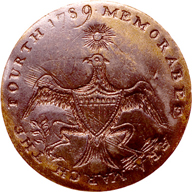 We.ve discussed Washington-related medals and
buttons in earlier issues. The upcoming November 15, 2008 Early American
History Auctions sale offers several of these. Here are a couple examples.
The first is Lot #2160: George Washington Inaugural Button .March The
Fourth 1789. Eagle and Sun. Next up is:
We.ve discussed Washington-related medals and
buttons in earlier issues. The upcoming November 15, 2008 Early American
History Auctions sale offers several of these. Here are a couple examples.
The first is Lot #2160: George Washington Inaugural Button .March The
Fourth 1789. Eagle and Sun. Next up is:
Baker 165A, Obverse 1, Reverse A1. 29mm. The purpose of this significant variety was to honor the George Washington upon his death. Holed, as always, at the top for suspension.
The rarity of the Skull & Crossbones variety is much greater than that of the Urn type. The Rulau/Fuld reference estimates of the surviving population of each type, the difference is a ratio of about 8-10 .Urn. types for every 1 .Skull and Crossbones. type.
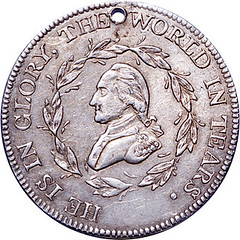
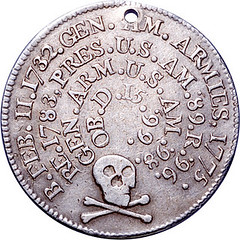
For more information, see: Lot 2160: George Washington Inaugural Button
Lot 2158: George Washington Funeral Medal
HALF DOLLAR "TAKEN FROM MOSEBY THE GUERRILLA"
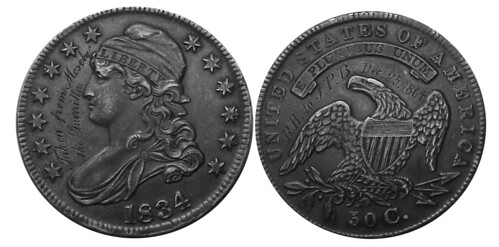
1363P. Capped Bust Half Dollar, 1834. .Taken from Moseby the Guerrilla. engraved in the left obverse field between the stars and the bust. The reverse is engraved .B.H. to J.P.B. Dec. 25. 1864. in the field above the eagle. Host coin is Choice EF with dark iridescent toning, highpoints being lighter.

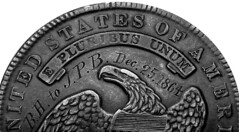
.Moseby the Guerrilla. is a direct reference to John Singleton Mosby (also spelled Moseby by the contemporary press), the Confederate guerrilla also known as the .Gray Ghost.. During the Civil War, Mosby joined Stuart.s cavalry at Bunker Hill, and made his first scout at Bull Run. Throughout the war he did much to harass the north. While in a sense independent, his command was always part of the cavalry of the army, and he made reports regularly to General Stuart or Lee.
Mosby.s activities during the war are well documented. The challenge is the inscription on this coin . could it have been taken directly from Mosby or one of his guerrillas in December of 1864? Why would he, or for that matter any of his men, be carrying such a high grade 1834 Half Dollar? Who were B.H. and J.P.B.? Union or Confederate soldiers?
Towards the closing months of 1864 the Federal Army was determined to put an end to Mosby's maraudering, yet they were frustrated in every attempt. "Mosby is an old rat," Colonel Charles Russell Lowell of the 2nd Massachusetts Cavalry wrote, "and has a great many holes."
"The whole country is full of guerillas," reflected Colonel Henry S. Gansevoort of the 13th New York Cavalry. Gansevoort "wearied of the thankless task of fighting guerillas," noting that "Mosby is continually around us."
Lieutenant General Ulysses S. Grant was so distressed by Mosby's successes that he ordered the partisan commander and his men hanged without trial when captured. Major General Philip Sheridan organized a special task force of 100 men armed with Spencer carbines to hunt down and destroy Mosby's command.
On November 18, 1864, Mosby killed or captured all but two of this force. Mosby was promoted colonel in December 1864 and his command had increased to 800 men, however, the war was by now coming to its conclusion. Twelve days after the surrender of General Robert E. Lee at Appomattox on April 9, 1865, Mosby reviewed his troops for the last time and disbanded them at Salem, Virginia. "I am no longer your commander," Mosby told his men, "Farewell."
A coin worthy of more research by the Civil War collector or history detective.
ALASKA NATIVE GOLD TOKENS NOW STRUCK WITH COLLAR
 Dick Hanscom of Alaska Rare Coins has kept us
informed about his work in creating modern tokens from native Alaskan
gold. In the October/November issue of the Alaskan Token Collector,
he published a short article on his latest process improvement.
Dick Hanscom of Alaska Rare Coins has kept us
informed about his work in creating modern tokens from native Alaskan
gold. In the October/November issue of the Alaskan Token Collector,
he published a short article on his latest process improvement.
-Editor
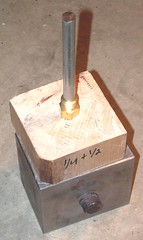 These tokens exhibit a smooth, square rim, and
the strike is marginally better. Frankly, these are so small that it is
hard to tell, but there is a difference, and all my = DWT tokens will be
made this way from now on.
These tokens exhibit a smooth, square rim, and
the strike is marginally better. Frankly, these are so small that it is
hard to tell, but there is a difference, and all my = DWT tokens will be
made this way from now on.These "prototype" tokens are made from a mixture of gold from unknown sources. We have a few of this test striking available for $38, postpaid.
Dick adds:
THE BOOK BAZARRE
GOOGLE SETTLES LEGAL BATTLE, SETS UP BOOK RIGHTS REGISTRY
As part of the settlement, Google is paying $125-million to settle the legal claims, pay legal costs for the two groups, and . more importantly . will set up a new entity called the Book Rights Registry, which will be responsible for distributing payments that come from online access to books provided through Google (and through any similar programs created by other providers). The registry will also be responsible for locating rights holders for old and out-of-print books, collecting and maintaining accurate info, and for providing a way for rights holders to .request inclusion in or exclusion from the project.. In effect, Google is setting up a body that does what ASCAP and similar groups do for musicians.
This settlement is a huge step forward for online and electronic access to books. As Google has repeatedly argued, this will make it substantially easier for authors and publishers to find, distribute and monetize out-of-print books...
CHINESE DEALER IN FAKE COINS SENTENCED TO JAIL
 A fake ancient coin dealer was sentenced to
three years in jail and fined at a Nanjing court days earlier, causing an
uproar in the collections society of whether the cultural relics market
should observe the modern business norm of credit.
A fake ancient coin dealer was sentenced to
three years in jail and fined at a Nanjing court days earlier, causing an
uproar in the collections society of whether the cultural relics market
should observe the modern business norm of credit. According to a report in the Market News, the Nanjing citizen surnamed Qin, sold 110 counterfeit ancient coins at 400 yuan each, claiming they were unearthed from a construction site. Qin pleaded not guilty of deceit, as there's an unspoken rule in trading antiques that it is the buyer's responsibility to determine the authenticity of the pieces.
An industry insider says it isn't deception to sell fake articles or deny returned goods on the collection market. People in this domain rely on their knowledge and experience to sort out masterpieces, and enjoy evaluating and differentiating antique articles, a shopkeeper at Nanjing Ancient Relics Market said.
Experts estimate as many as half of antiques dealers would face jail terms in China if the country punishes them using current laws for common businesses, and more astonishingly, Professor Yang Jingrong, a pottery expert at the Forbidden City, said during an interview with the Beijing Morning News that 95 percent of all articles on the antiques market were fakes.
To read the complete article, see: Should fake antique dealers be punished? (http://www.chinadaily.com.cn/china/2007-02/27/content_814924.htm)
ARTICLE DISCUSSES COIN'S "TREASURE IN THE CELLAR" CONNECTION
Readers are still fascinated with the tale of Theodore Jones and Henry Grob, poor Baltimore teens who unearthed gold coins in the basement of an Eden Street tenement in 1934.
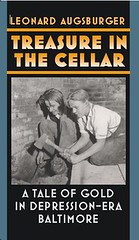 What brought the story back from musty
newspaper and legal archives was the recent publication of Leonard
Augsburger's Treasure in the Cellar: A Tale of Gold in Depression-Era
Baltimore.
What brought the story back from musty
newspaper and legal archives was the recent publication of Leonard
Augsburger's Treasure in the Cellar: A Tale of Gold in Depression-Era
Baltimore.Howard J. Sapp, 80, a retired Social Security Administration disability examiner, wrote me. He said that one of the boy's parents paid a debt to his grandfather, owner of a Caroline Street store, with a 2 1/2 -dollar gold piece from the stash.
After reading my story, Sapp remembered the gold coin - also known as a Quarter Eagle - and the story of the boys. He determined he would solve the mystery of the coin that had remained in his family for 74 years and report back to me.
"My sister, June Patz, is wearing it around her neck right now," Sapp said in a phone call.
In the official inventory of the gold coins, there were seven 2 1/2 -dollar gold pieces that dated to 1854, and the Sapp family piece was one of them.
"Some years ago, she took it to a jeweler who told her it was worth about $100 in gold and then offered her $600 for it," Sapp said. "She didn't sell it and instead had a necklace made out of it."
"So, it's happily around the neck of an 83-year-old widow who lives in Stevenson," he said.
To read the complete article, see: Gold coin and Rodgers Forge stories return (http://www.baltimoresun.com/news/local/bal-
id.backstory19oct19,0,5546589.column)
ALPHONSE ANTON KOLB, SCULPTOR (1893 - 1983)
Harry Watterson writes:He was a sculptor, designer, and engraver and worked for Bastian Brothers Co. striking metal dies for medals, plaques, and buttons for nearly 50 years. Kolb worked in clay, bronze, steel, wood, silver, and gold, and his works ranged in size from dime−size coins to plaques several feet high. His many works include designing and sculpting the medal for Rochester.s centennial in 1934, the medal commemorating the 1,000th meeting of the Rochester Numismatic Association, the medal marking the association.s 50th anniversary in 1962, and many others.
At the age of 65, he decided to retire. He and his second wife, Kathryn, traveled for a time, but after her death in 1968, he decided to return to work. "I can.t be without my work," Kolb said. "It.s the best thing for me."
Kolb was also a coin and medal collector and had a rose garden at his home. He was a lifetime member American Numismatic Association, the Rochester Numismatic Association, and the Albany Numismatic Society. As a member of the Rochester Numismatic Association, Kolb designed and struck dies for the medal awarded to the outgoing president of the organization bearing that person.s likeness. Kolb held this responsibility from 1920 to 1976, and was himself president of the organization in 1931.

The bronze plaque is signed in the lower left corner with "A. A. Kolb, SC," a mark which was common to much of Kolb.s work. The "SC" after his name stands for "Sculptor." There is no official record of the poem "Love.s Symphony," so it is assumed that the creator of the plaque is the author of the poem. The poem refers to the joy that love brings to one.s life. It seems an appropriate tribute from a husband to his wife.
To read the complete paper, see: Kolb Memorial (https://urresearch.rochester.edu/retrieve/327/kolb/pdf)
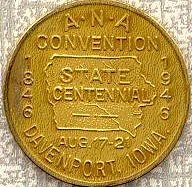
WELSH TREASURE HUNTER UNEARTHS 6,000 COINS
The pots. combined contents of 5,913 copper-alloy coins from the early fourth century were uncovered over two days in April near Sully, in the Vale of Glamorgan. Most of the coins were minted in London, Trier and Lyon, but some came from more distant imperial outposts in what is now Croatia and Syria.
National Museum Wales numismatist Edward Besly said the Emperor Diocletian reformed the Roman currency around 295AD, although some of the coins belonged to an earlier denomination.
He said: .They are the same standard, same design. .An early single currency is one way of looking at it..
To read the complete article, see: Treasure hunter unearths 6,000 gold coins (http://www.walesonline.co.uk/news/wales-news/
2008/10/30/treasure-hunter-unearths-6-000-gold-coins-91466-22154391/)
TALES OF CRANKY BOOKSELLERS
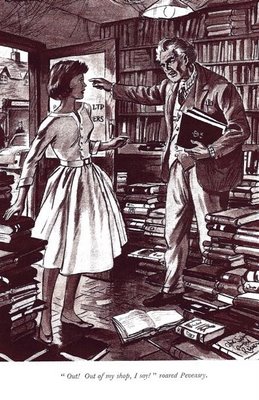
Perplexed, the man froze like a deer in the headlights. I was perplexed, too. With books piled hither and yon, it was impossible to see where the dealer's countertop began or ended. The customer had veered behind the counter while following a narrow pathway. He turned and walked out, surely muttering that it would be a cold day in hell before he'd spend a dime in that shop. -Editor
NOTES AND CORRECTIONS
Joe Boling writes: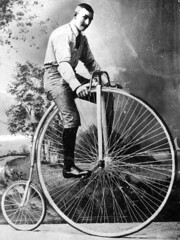 In last week's Wayne's Words I wrote:
In last week's Wayne's Words I wrote:
Yossi Dotan writes:
NATIONAL COLLECTOR'S MINT COIN INCORPORATES LIGHT AND SOUND
While visiting my Mom in Pittsburgh last weekend I caught a commercial on television for one of the new products from the National Collector's Mint. You've got to hand it to private mints for advances in coining technology.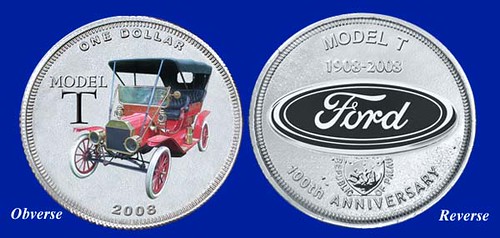
From the company's web site:
The most important car in history! And now -- for its centennial celebration -- we release the first ever pure silver clad 2008 Ford Model T Dollar. colorized in original Model T Red, with headlights that light up and the sound of the original Tin Lizzy Brass Bulb horn!
It.s a government authorized non-circulating legal tender tribute to America.s most famous car that still holds the all-time production record of 2.2 million vehicles in one year. Watch the headlights light up and listen to the sound of the original 1908 horn when you press the Ford logo on the reverse.
FEATURED WEB PAGE: MONETA'S E-PAPERS LINKS PAGE
This week's featured web page is suggested by Georges Depeyrot of Paris. He writes: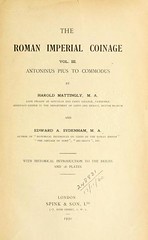
www.moneta.be/content.htm
